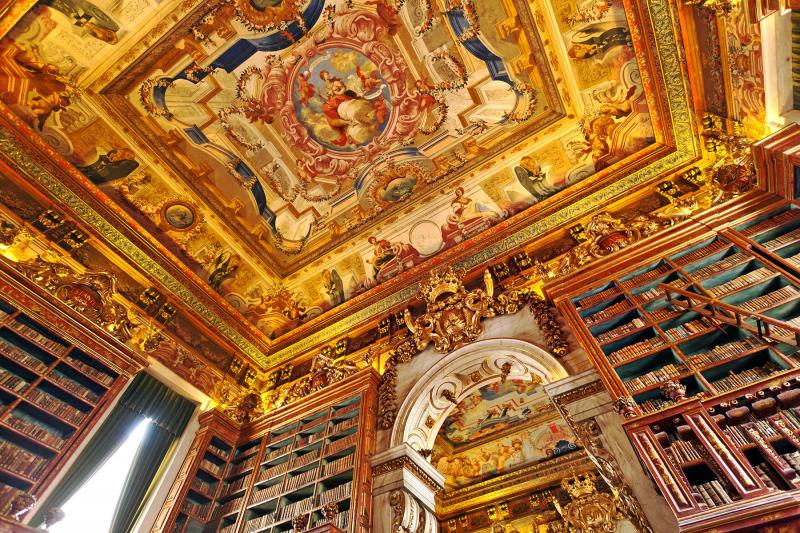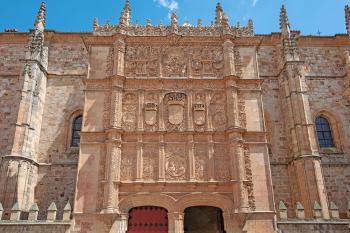Academic adventures: Visiting Europe's top university sights
Appears in the Online Edition, August 2019.
When touring any city, it's fun to drop in on the local university. But in Europe, universities can be essential sightseeing, as some are home to great architectural, artistic, and cultural treasures.
One of Europe's top university sights is the Book of Kells, tucked away in the library of the venerable Trinity College in Dublin. This famous illuminated manuscript is a 1,200-year-old version of the four gospels, elaborately inked and meticulously illustrated by faithful monks, who went to great lengths in creating the 680-page book.
To make the vellum pages, they laboriously scraped and dried the skin of an estimated 185 calves. To get the most vivid pigments, they used powders from crushed bugs and precious stones. They wrote in Latin calligraphy and adorned the pages with big, flowery letters, detailed illustrations, and animals crouching between sentences or intertwined with letters -- a jungle of intricate designs, inhabited by tiny creatures both real and fanciful.
If you visit, you won't be alone: As this is a popular sight with long lines, it's best to buy timed-entry tickets in advance (see www.tcd.ie/visitors).
More than any country in Europe, Great Britain is synonymous with prestigious universities. While several are worth touring, from a sightseeing point of view, I enjoy Cambridge, near London. Two of Cambridge's highlights are the King's College Chapel and Wren Library.
The 500-year-old chapel is England's best surviving example of late Gothic architecture, a style emphasizing perpendicular lines. It boasts the largest single span of vaulted roof anywhere -- 2,000 tons of glorious fan vaulting -- and the most complete collection of original 16th-century Renaissance stained glass in existence. Scenes from the New Testament decorate the lower panes, while corresponding stories from the Old Testament are in the upper windows. Adorning the altar is the Adoration of the Magi, one of many versions painted by the famous Flemish Baroque painter Peter Paul Rubens.
The Wren Library, at Trinity College, features the light and airy design of Sir Christopher Wren -- the architect who designed St. Paul's Cathedral in London. Unlike other libraries at Cambridge, this one is on an upper floor, allowing it to be flooded with light. The 12 display cases contain a rotating collection of items, such as early editions of Shakespeare's plays, handwritten works by John Milton, Sir Isaac Newton's notebook and prism, and A. A. Milne's original "Winnie the Pooh."
Another treasured library is the elegant King Joao's Library (Biblioteca Joanina), at Coimbra University in Portugal. This Baroque display showcases 40,000 books in 18th-century splendor. Accessible only during appointed times, the library gives visitors 10 minutes to view this 300-year-old temple of thought. The interior is all wood, including reading tables inlaid with exotic South American woods, bookshelves built with clever hideaway staircases, and even "marble" (actually painted wood) on the arches of triumph that divide the library into rooms. The painted ceiling demonstrates the illusions of Baroque's trompe l'oeil.
Since the library's books all date from before 1755, a major job here is preservation. The zealous doorkeeper opens the big front door sparingly to keep out humidity, and only long enough to let visitors sneak quickly out. At night, resident bats come out to devour book-eating insects, providing a chemical free way of protecting the collection.
In Salamanca, home to Spain's oldest university (established around 1218), the highlight is the school's grand entrance facade. The intricate stonework is a great example of Spain's Plateresque style, represented by delicate, detail-packed, filigree-like carvings.
The facade has three sections. The bottom celebrates the "Catholic Monarchs," Ferdinand and Isabel, who granted money for the building. The immodest middle section celebrates their grandson, Charles V, who commissioned this facade and decorated it with the complex coat of arms of the mighty Habsburg Empire.
The top shows the pope flanked by Hercules and Venus -- a statement of intellectual independence from medieval Church control. Buried amidst the ornamentation is a tiny frog on a skull that students look to for good luck.
Founded around the same time as University of Salamanca, Italy's University of Padua is one of the first, greatest, and most progressive schools in Europe. Independent of Catholic constraints, this haven for free thought ushered in intellectuals from all over the continent, including Copernicus, who studied here, and Galileo, who taught here.
Students lead tours of the university, highlighted by a peek at Europe's first great Anatomy Theater (from 1595). Because of the Church's strict ban on autopsies, the university operated on a "don't ask, don't tell" basis. Despite that, more than 300 students would pack this theater to watch professors dissect human cadavers -- mostly bodies of criminals from another town.
From ancient autopsy rooms to glimmering Gothic chapels, medieval manuscripts to dark Baroque libraries, Europe's universities can provide an intimate setting to experience some of history's most impressive artifacts.
(Rick Steves (www.ricksteves.com) writes European travel guidebooks and hosts travel shows on public television and public radio. Email him at rick@ricksteves.com and follow his blog on Facebook.)


